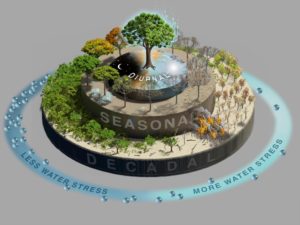Using microwave remote sensing to observe vegetation water content
The Science
Hot droughts are becoming more common because of climate change, but we still do not know how forests respond to water stress conditions. Field measurements are too sparse and most satellite measurements cannot detect early signs of water stress in forests. Microwave measurements from space can be used to estimate vegetation water content and detect water stress across all forests on Earth. Vegetation water content is useful because plants lose internal water when they are stressed or when they die.
The Impact
A team of researchers with expertise from field measurements, remote sensing, and numerical models identified opportunities and challenges for using volumetric water content from remote sensing to detect water stress. For example, the time between measurements matters: changes from year to year are useful for seeing changes in forest structure, whereas changes across weeks relate to how much water plants are able to store. The team identified the need for a geostationary spaceborne observational system to measure water content. This system would provide important data on water fluxes from day to day, and could help to identify the earliest signs of water stress in forests.
Summary
This research review describes how extensive and frequent estimates of volumetric water content from microwave remote sensing could improve our ability to detect signs of water stress and anticipate critical conditions for fire and mortality in forests across the world. It could also allow for inference of belowground soil moisture and root water uptake conditions across large scales, which is challenging otherwise. Researchers also identified the need to establish relationships between volumetric water content and ecosystem-scale water potential to be able to detect signs of stress across different forest systems, and to be able to effectively link remote sensing measurements with terrestrial biosphere models. In addition, it is critical to improve methods to distinguish variations in water content due to changes in surface water (dew and rainfall interception) and changes in water stored inside plants.
This review also points to the need for field campaigns that will help establish the volume-potential relationships at ecosystem scale, which are critical to define thresholds for wilting, mortality, and fire risks in different forests. Finally, the monitoring of forest water stress could greatly benefit from geostationary measurements of volumetric water content, which would provide information at sub-daily scale, which could be more directly related to field measurements and improve the quantification of water stress.

Contact
Alexandra Konings, Stanford University, Department of Earth System Science, konings@stanford.edu
Funding
This work is a result from discussions initiated at the Sensing Forest Water Dynamics from Space: Towards Predicting the Earth System Response to Droughts workshop, which supported by the W.M. Keck Institute for Space Studies. This research was partially supported by the Next Generation Ecosystem Experiments-Tropics, funded by the U.S. Department of Energy, Office of Science, Office of Biological and Environmental Research. This research was also funded by NSF, and NASA Terrestrial Ecology. The research carried out at the Jet Propulsion Laboratory, California Institute of Technology, was under a contract with the National Aeronautics and Space Administration. Oak Ridge National Laboratory is managed by UT-Battelle, LLC, for the U.S. DOE.
Publications
Konings, A. G., S. S. Saatchi, C. Frankenberg, M. Keller, V. Leshyk, W. R. Anderegg, V. Humphrey, A. M. Matheny, A. Trugman, L. Sack et al., Detecting forest response to droughts with global observations of vegetation water content. Global Change Biology 27, 6005–6024 (2021). [DOI: 10.1111/gcb.15872]